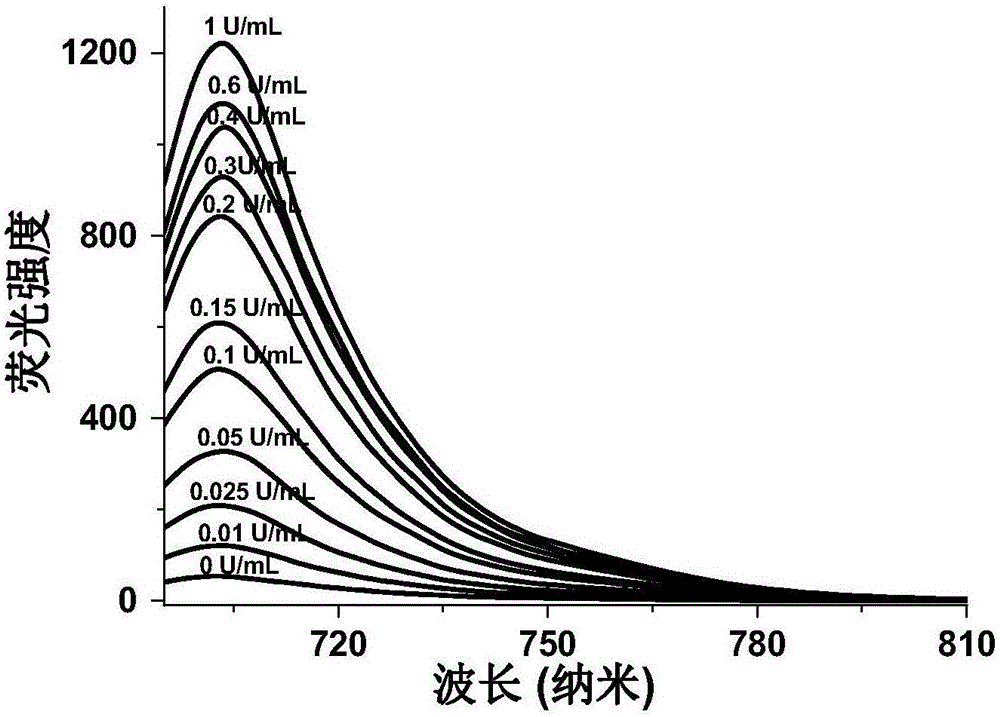Fluorescent probe and pesticides residue detection kit based on carboxylesterase inhibition method
A technology of fluorescent probes and carboxylesterases, applied in fluorescence/phosphorescence, chemical instruments and methods, luminescent materials, etc., to achieve fast reaction speed, high sensitivity, and simple post-processing effects
- Summary
- Abstract
- Description
- Claims
- Application Information
AI Technical Summary
Problems solved by technology
Method used
Image
Examples
Embodiment 1
[0057] Embodiment 1: the preparation of fluorescent probe shown in formula (I)
[0058]
[0059] The experimental procedure is as follows: Dissolve the tricarbocyanine IR-780 skeleton (0.41g, 1.0mmol) in N,N-dimethylformamide (10mL), and add 4-(chloromethyl)phenylacetate to it (0.18g, 1.0mmol) and catalyst potassium carbonate (0.21g, 1.5mmol), and the resulting reaction system was reacted at 45°C for 2 hours. After the reaction was completed, it was cooled to room temperature, and the solvent was removed under reduced pressure to obtain a crude product. The obtained crude product was purified by silica gel column chromatography (petroleum ether / ethyl acetate (v / v)=1 / 1) as the eluent to obtain 0.29 g of a blue-green solid product.
[0060] The structural characterization data results of the fluorescent probe are as follows:
[0061] 1 H NMR (600MHz, CD 3 OD) δ (ppm): 8.67 (d, J = 14.9Hz, 1H), 7.57 (d, J = 7.5Hz, 1H), 7.48-7.40 (m, 4H), 7.40-7.33 (m, 2H), 7.29 (s,1H),7...
Embodiment 2
[0063] Embodiment 2: the spectral properties of fluorescent probe shown in formula (I) reacting with different concentrations of carboxylesterase
[0064] Dissolve fluorescent probe solution b (1mM, 50μL) in phosphate buffer (10mM, 5mL), then add different concentrations of carboxylesterase standard solutions, and then dilute to 10mL with 10mM phosphate buffer. The concentrations of carboxylesterase in different carboxylesterase standard solutions were 0, 0.01, 0.025, 0.05, 0.1, 0.15, 0.2, 0.3, 0.4, 0.6 and 1 U / mL. The volumes of the solutions of the series of carboxylesterase standard products with different concentrations are all 2mL. React at 37°C for 15 minutes, and measure its UV-Vis absorption spectrum and fluorescence emission spectrum. When measuring the fluorescence emission spectrum, the excitation wavelength is 650nm; the slit width for excitation and emission is 10nm; the voltage is 700V. Experimental results such as figure 1 as shown, figure 1 is the fluores...
Embodiment 3
[0068] Embodiment 3: Fluorescent probe shown in formula (I) reacts with other substances (selectivity research)
[0069] Various substances were added to the 10 μM fluorescent probe solution: potassium chloride (150 mM), calcium chloride (2.5 mM), magnesium chloride (2.5 mM), glucose (10 mM), reactive oxygen species (10 μM), glutathione (5mM), cysteine (1mM), homocysteine (1mM), human serum albumin (0.5mg / mL), bovine serum albumin (0.5mg / mL), acetylcholinesterase (0.1μg / L), butyrylcholinesterase (20U / L) and carboxylesterase (1U / mL). After reacting at 37°C for 15 min, the fluorescence emission spectrum was measured using a fluorometer F-4600. When the fluorescence emission spectrum is measured, it is de-excited at 650nm; the slit width for excitation and emission is 10nm; the voltage is 700V. 50 µL of the probe solution (1 mM) was added to 10 mL of the solution in which the above-mentioned substances were mixed, and carboxylesterase was added to make the final concentr...
PUM
 Login to View More
Login to View More Abstract
Description
Claims
Application Information
 Login to View More
Login to View More - R&D
- Intellectual Property
- Life Sciences
- Materials
- Tech Scout
- Unparalleled Data Quality
- Higher Quality Content
- 60% Fewer Hallucinations
Browse by: Latest US Patents, China's latest patents, Technical Efficacy Thesaurus, Application Domain, Technology Topic, Popular Technical Reports.
© 2025 PatSnap. All rights reserved.Legal|Privacy policy|Modern Slavery Act Transparency Statement|Sitemap|About US| Contact US: help@patsnap.com



